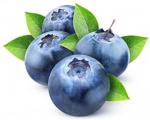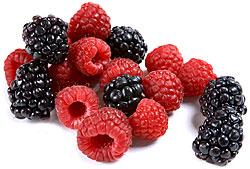Select a location with at least 6 hours of sun. Afternoon shade is preferred to morning shade.
The most important thing about growing blueberries successfully is soil pH. Blueberries REQUIRE a soil pH of 4.5 to 5.5. Normal soil pH in the Sacramento region is about 7. Plan to test your soil pH every year because it will change over time.
For less than $20, it’s easy to check soil pH yourself at home. Soil test kits require distilled water to make a soil solution. You might prefer a soil pH meter with probes that are inserted in the soil. There are many of both available at local garden stores or online. Two examples are:
- Rapitest Soil Test Kit by Luster Leaf* (also tests soil nutrients)
- Soil pH Meter, Jellas 3-in-1 by Jellas* (also tests moisture and light)
(click to enlarge)
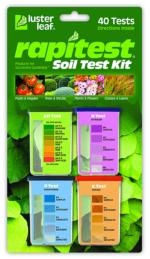
Kit* - tests pH and nutrients
|
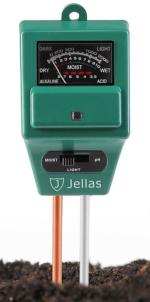
Probe* - tests pH, light and moisture
|
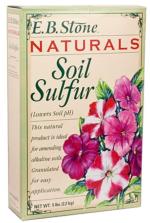
Soil sulfur lowers soil pH*
|
*No endorsement of these products/companies is intended, nor is criticism implied of similar products/companies that are not included. UC Cooperative Extension
For the most accurate analysis of your soil, consider sending a sample to a soil test lab. (PDF) Call for pricing.
To adjust pH in your soil, use soil sulfur (available at garden stores - follow directions on the box for quantity) and incorporate into the soil at least 6 months before planting when possible. For established blueberries, check the pH of your soil each spring and determine the amount of soil sulfur required to lower the pH to 4.5 to 5.5. Divide that amount in half and apply that quantity in the spring and the other half in the fall. For additional information, refer to our video Blueberries: Amending your Soil's pH (4:10 min.).
Blueberry plants are self-pollinating; meaning they will produce fruit with only one plant. However, a second plant of another variety that blooms about the same time will result in considerably more fruit for both.
See more on planting, seasonal care and harvest in the monthly lists below.
Cane Berries
For details on recommended varieties, growing, trellising, pruning and much more, refer to Growing Cane Berries in the Sacramento Region. (PDF - EHN 86)
Select a location with at least 6 hours of sun. Plants are available with or without thorns in many varieties.
Cane berries (blackberries, boysenberries and raspberries) aren’t as fussy about soil pH as blueberries, but for optimum growth and fruit, they prefer a soil pH of 5.5 to 6.5—normal in the Sacramento region is about 7.
Blackberries, boysenberries and raspberries have a perennial root that produces canes that live for only two years.
Blackberries and boysenberries require the support of a trellis system. Their canes will root where they lie on the ground.
There are three types of raspberry plants (check labels): summer-bearing, black and everbearing (also called fall-bearing). Raspberries can be invasive. Grow them in a raised bed or be prepared to control their growth. We grow 'Heritage' and 'Fall Gold' (both everbearing varieties) at the Fair Oaks Horticulture Center.
Summer bearing and black raspberries produce new canes from the ground at the same time they bear fruit on last year’s canes. Harvest is May through June.
Everbearing (also called fall-bearing) varieties grow new canes in spring that produce fruit in the same season. These canes can be pruned to produce a second crop in the next year. See more on this below under winter pruning.
To prevent fruit from burning, all caneberries need some shade during fruit production in summer in the Sacramento region.
Strawberries
For details on recommended varieties, seasonal care and much more, refer to the University of California Garden Web.
Strawberries are an easy crop to grow in the home garden. Once established, strawberry plants can produce an abundance of fruit for several years.
There are two types of strawberries: short-day cultivars and day-neutral cultivars. Short-day cultivars produce fruit when days are short and cool in late fall, winter and early spring. Day-neutral varieties produce fruit much of the year, even during the winter in mild coastal climates.
Strawberries can be planted whenever they are available, however they are best planted in late summer to early fall to produce the following spring. Select a a well-draining location with at least 6 hours of full sun.
Strawberries should be fertilized regularly, a couple weeks after planting or when they send our new growth and every two months until late September.
Trim off runners as they develop since the runners pull energy away from the mother plant and reduce fruit productivity.
Elevated planting troughs have been installed at the Fair Oaks Horticulture Center for the addition of two strawberry types, 'Sequoia.' a short-day variety and 'Albion,' a day-neutral variety.
Monthly Checklists
For detailed information on all aspects of growing berries, please refer to:
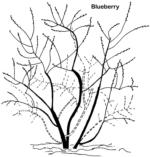
Prune blueberries
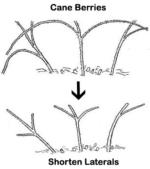
Prune cane berries
|
January/February Blueberries
- Prune. For new plants during their first 2 years, prune spindly, dead, diseased or damaged branches. Older plants (3 years or more) need more pruning. See pruning details in: Growing Blueberries in the Sacramento Region (PDF - EHN 88) and our video Pruning Mature Blueberry Plants (5:02 min.).
- Plant bare root or dormant potted plants when they are available at nurseries, usually late December through February.
- The most important thing about growing blueberries successfully is soil pH. You should get a pH meter or testing kit and learn to use it. See above for choosing a pH meter.
- Blueberries REQUIRE a soil pH of 4.5 - 5.5. Normal in Sacramento region is about 7. To adjust pH in your soil, use soil sulfur (available at garden stores) and incorporate into the soil before planting. If you are planting in the ground, you should add soil sulfur at least six months in advance. For container planting you can use an acidic soil mixture. See the planting and spacing section in Growing Blueberries in the Sacramento Region for a soil mix recipe.
- Plants from the Southern Highbush group are best suited to Sacramento’s hot summers and relatively warm winters. Some Northern Highbush blueberries can also do well. Look for a chill hour requirement of less than 800. See the list of plants we grow at the Horticulture Center on the last page of our Growing Blueberries in the Sacramento Region (PDF) This is not a complete list of plants available at nurseries!
- Blueberries appreciate some afternoon shade, but will tolerate full sun. Select a location with at least 6 hours of sun.
- Plants are self-pollinating; meaning they will produce fruit with only one plant. However, a second plant of another variety that blooms about the same time will result in considerably more fruit for both.
- Blueberries are shallow rooted about 3 to 4 feet wide. Dig soil this wide and 1 to 2 feet deep. They need well-drained, porous soil high in organic matter. With hardpan, consider raised beds or containers. If possible, add soil sulfur at least six months in advance to reduce soil pH before planting.
Cane Berries
- Prune. See pruning details for all cane berries in: Growing Cane Berries in the Sacramento Region. (PDF)
- For most cane berries, cut new canes back to 5 to 6 feet and shorten lateral branches to 12 to 18 inches or approximately 9 buds.
- If you didn’t remove last year’s fruiting canes, cut those back to the ground—they will not produce fruit again and will make the plant difficult to control.
- For fall bearing (everbearing) raspberries you have two choices--remove the entire cane to the ground or cut off the top half of the canes that fruited last year.
- If you leave half of the cane, you will get a second crop the following June.
- Plant bare root dormant cane berries. Choose a sunny site with at least 6 hours of sun (afternoon shade for raspberries).
- Soil pH of 5.5 to 6.5 is ideal. Most berries are shallow rooted, 3 to 4 feet wide and about 1 foot deep. Add well-decomposed organic matter to the soil to help with drainage (or use raised beds or containers).
- Space blackberries and boysenberries about 4 feet apart, raspberries about 3 feet. Irrigate and cover the soil around each plant with mulch, such as wood chips.
- For more on raspberries, also refer to http://cagardenweb.ucanr.edu/Berries/Raspberries/
- Feed container plants with fertilizer at one-half strength.
|

Soil sulfur lowers soil pH*
|
March
- Plant blueberries and cane berries purchased in pots or sleeves. Refer to January/February above for details.
- Cane berries - fertilize and mulch. Gently move existing mulch away from plant without digging into shallow roots. Spread fertilizer, water it in and then cover with mulch.
- Blueberries - Test soil pH, fertilize and mulch. Watch our video Blueberries: Amending Your Soil's pH (4:10 min.) for better blueberries.
- For established plants where the soil pH tests above 5.5, apply half of the required sulfur now and follow up in October with the other half needed.
- Find Soil Sulfur* at garden stores.
- Carefully move existing mulch away from the plant taking care not to damage shallow roots. Sprinkle the sulfur and fertilizer on the soil under the plant, water it in and cover with mulch. Sulfur and fertilizer should be applied at the same time. Using an acidic fertilizer, such as those used on azaleas, hydrangeas and gardenias will help to keep the soil at the desired pH.
- Strawberries: apply high nitrogen fertilizer.
- Check irrigation and begin watering when rain stops.
- Test, repair, and flush out the irrigation system, including sprinkler heads and drip emitters.
- Verify that the irrigation timer is working and set for the amount of water needed.
- Moist but not wet soil is critical during blueberry and cane berry fruit development.
|
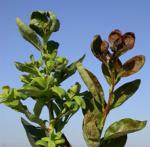
Thrips damage on blueberry
|
April
- Cane berries and blueberries are blooming. Some blueberries will begin bloom before Christmas.
- Remove flowers from newly planted blueberries. This allows the plant to spend energy developing strong roots rather than fruit. You can harvest in year two!
- Add a thick layer of mulch (such as wood chips) under your berry plants to protect shallow roots and keep soil moist.
- Manage pests. Thrips are sometimes a problem on Blueberries. Heavy infestations cause new foliage to curl or twist. If you see this, shake a branch over a piece of white paper to see if tiny specs (insects) are present. Thrips Pest Note, UC ANR Publication 7429.
|
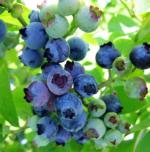
Blueberries ripening
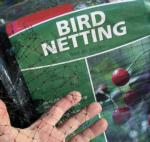
Bird netting
|
May
- Begin harvesting early season blueberries.
- Like other berries, blueberries don’t all ripen at once so many pickings are needed. This is one reason they are so expensive to buy.
- Wait one week after berries turn blue before picking for the sweetest taste. Ripe blueberries will fall into your hand or a bucket when you gently “tickle” the cluster of berries.
- Install shade cloth in advance of hot days over berries growing in full sun.
- Fruit on blueberries grown in afternoon shade will ripen about 1 month later. It will not affect the quantity of fruit.
- Feed container plants with half-strength acidic fertilizer.
- Begin harvesting boysenberries, summer-bearing raspberries and strawberries.
- Harvest blueberries and cane berries about every 3 days to keep up with newly ripened berries.
- To prevent birds from eating your ripe berries, ee use a structure made of PVC pipe covered with bird netting for blueberries. Seal openings or birds will sneak through or under. Drape netting over trellised cane berries. Lift netting to harvest. Refer to our video Bird Netting Your Blueberries (2:35 min.).
- Check irrigation. Moist but not wet soil is critical during blueberry and cane berry fruit development.
- Tie cane berries to a trellis if not already done.
|
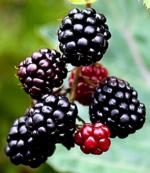
Harvest cane berries
|
June
- Begin harvesting blackberries late this month.
- Continue harvesting blueberries, boysenberries, raspberries and strawberries.
- Check irrigation. Moist but not wet soil is critical during blueberry and cane berry fruit development.
|
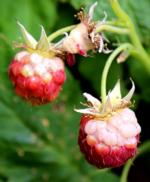
Protect raspberries from sunburn
|
July
- If raspberries receive afternoon sun, provide shade cloth to prevent sunburn.
- Blackberry and boysenberry fruit will also benefit from shade cloth to keep the fruit from scorching.
- If blueberries send up long shoots without growth on the bottom, consider cutting them back by half to encourage branching out and more fruit for the following spring.
- Feed containers with half-strength fertilizer.
- Check irrigation. Moist but not wet soil is critical during blueberry and cane berry fruit development.
|
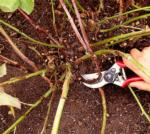
Remove canes that made fruit this year
|
August
- Once blackberries, boysenberries and summer-bearing raspberries have finished fruiting, cut all canes that bore fruit to the ground.
- For blackberries and boysenberries, shorten new canes to 5 or 6 feet long. This will make January pruning simpler.
- If you plan to propagate new plants over the winter, don’t shorten the new canes. See November for propagation tips.
- Begin harvesting fall-bearing (everbearing) raspberries.
- Check irrigation. Moist but not wet soil is critical when blueberry and cane berry plants set buds that will produce fruit next year.
- Feed containers with half-strength fertilizer.
|
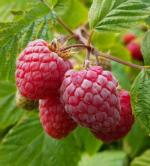
Fall-bearing raspberries
|
September
- Continue harvesting fall-bearing (everbearing) raspberries, and provide shade as needed to prevent sunburn on fruit and leaves.
- Feed containers with half-strength fertilizer.
- Strawberries: apply high-nitrogen fertilizer.
- Check irrigation. Moist but not wet soil is critical when blueberry and cane berry plants set buds that will produce fruit next year.
|
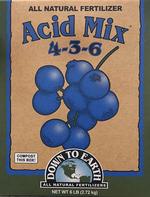
Fertilize now*
|
October
- Fertilize* and mulch cane berry plants. Gently move existing mulch away from plant without digging into shallow roots. Spread fertilizer, water it in and then cover with plenty of mulch.
- Fertilize and mulch Blueberries; add sulfur if needed.
- For established plants where the soil pH tested above 5.5 in spring no need to test again. Apply second half of soil sulfur now.
- Find Soil Sulfur* at garden stores.
- Carefully move existing mulch away from the plant taking care not to damage shallow roots. Sprinkle fertilizer and sulfur (if needed) on the soil under the plant, water it in and cover with mulch. Sulfur and fertilizer should be applied at the same time.
- Feed containers with half-strength fertilizer.
|
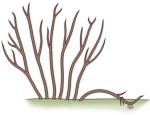
Propagate cane berries
|
November
- Propagate new blackberry plants. Allow new canes to rest on the ground or a pot of soil to root over winter. Transplant when roots have formed.
|
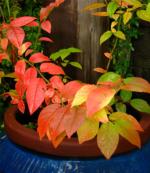
Many blueberries display fall color
|
December
- Enjoy fall color from some blueberry plants.
- Clean up around berries.
|
*No endorsement of products/companies is intended, nor is criticism implied of similar products/companies that are not included. UC Cooperative Extension
